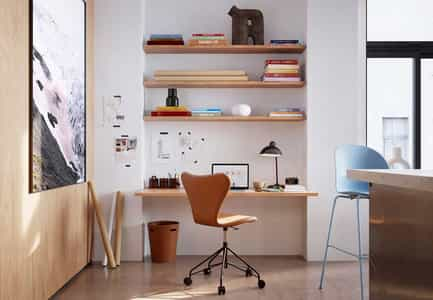We've left 2022, and, say what you want about this wholly challenging, demanding, and difficult year — it was a year that brought forth many changes that will shape future trends in the marketplace for numerous industries. This is especially true in the furniture industry, where trends come and go in both style and substance as well as in the way furniture is marketed to consumers.
2023 will be interesting for the furniture industry, to say the least. The consumer wants and needs have changed drastically over the last year, and while they, of course, will always need furniture, the bills for gas and food are taking precedence across the world. Brands will need to withstand the decline in demand and make sure they stay on top of their customers' minds once the recession ends.
At the same time, universal processes, such as remaining CX-focused and providing solutions for customer pain points throughout the customer journey, must always remain at the forefront of a brand’s marketing strategy.
Consider using technological advancements that will help you optimize your marketing budget instead of cutting down during the tough years. Because only the brands that won't halt their marketing activities can stay competitive once the demand will rise.
You might also like: Keep advertising through times of crisis
More demand for furniture via e-commerce

Over the past decade, plenty of furniture brands have set up e-commerce webshops, but the majority of them were designed to entice you to come into the brick and mortar showroom, rather than make a direct purchase online. But more and more customers are making the switch to shopping for furniture online as brands discover ways to showcase their furniture products in innovative and visually appealing settings using advanced technology such as ImageScripting, WebAR, and product configurators. Which brings us to our next big furniture trend for 2023…
Taking advantage of technology
In an increasingly competitive and over-saturated industry, as well as one in which consumers preferred to see and touch products in person, furniture businesses needed to develop new ways to showcase their products online. The technologies mentioned above have certainly paved the way for furniture brands to appeal to those consumer pain points and display products in a visually stunning, photorealistic manner.
You might also like: "Technologies that drive revenue in the furniture industry"
Brands who are taking advantage of those technologies are increasing online sales via advanced imaging tools that enable consumers to view products in all styles and colors, rotate products, zoom in and out, and even see hidden components, all with a few simple clicks of the mouse. And, when paired with WebAR, customers can even easily visualize how a particular piece of furniture will look in their own home, along with their other furniture and décor. It helps customers find the perfect piece, without ever having to leave their home.
Here's an example of how Bolia has used their 3D images to leverage AR technology to make it possible for customers to place their preferred furniture piece directly into their own homes.
Fast and free shipping options
Free shipping can no longer be offered as a special promotion for customers who spend a certain dollar amount or a holiday savings deal. Customers who shop heavily online now expect free shipping as part of the norm, and they want their products shipped fast, too. Lots of major retailers already offer this on a regular basis, but the furniture industry is catching on and catching up, with many brands now doing the same. In order to remain competitive, expect more furniture businesses to follow this trend in 2023.
Easy financing options
Let’s face it — if you aren’t offering your customers financing options for furniture and other home décor accessories, then you are certainly behind the times on this furniture trend. Today, nearly everything can be financed, from car repairs to dental bills to mattresses and even small purchases from major e-tailers.
The furniture industry has offered financing for many decades, but today, consumers not only expect to be provided with easy financing options, they also want to be able to get approved either in-person or online within minutes so that they can make their purchase and enjoy their furniture right away. This is also an important component of delivering good CX — if customers aren’t satisfied with the payment and financing options you provide, they may go somewhere else that better fulfills their needs.
Cash and carry options
Many successful furniture brands today are successful because they have realized a customer pain point in the retail industry and made the necessary changes to solve that problem — essentially, customers don’t want to wait weeks or more than several days for a piece of furniture anymore. Millennials are especially determined to purchase and bring home their furniture within a day, or have it delivered just as quickly. As the largest demographic purchasing furniture today[i], millennials don’t want to be told that a piece will take time to be assembled. As a result, many brands now cater to the crowd, offering pre-assembled pieces in a variety of colors or upholstery options for easy pickup or quick delivery.
Providing a more personalized experience
This is another important component of delivering outstanding CX, regardless of industry. But in the furniture industry, it is also important because it can mean the difference between growing your customer base or losing customers to competitors. Furniture brands will be taking steps to better know their target audience and provide them with personalized guidance and suggestions, helping them to find the perfect piece. Online, brand e-commerce managers and marketers can utilize technology, social media marketing, and a combination of the two to reach customers on social channels and present products with high-quality 3D images of their furniture products and WebAR experiences.
Ultimately, the omnichannel experience[ii] will further drive personalization and transform social channels into extensions of furniture webshops whereby an audience can collectively discover and discuss brands and the products they offer. Subsequently, this cultivates an environment that also increases brand recognition and provides customers with the information they need to keep moving further along the customer journey map.

Identifying the customer
Also part of providing a more personalized experience, some brands are attempting to utilize facial recognition and other advanced identification tools to identify customers as they walk into a showroom. This has proven to be challenging, but is nonetheless a consideration by nearly 75% of retailers. Part of the challenge has been getting customers to realize that there is some value in allowing retailers to identify them.
This trend may be slow-going and slow-growing, but the furniture industry in particular can leverage both online engagement and in-store engagement to further inspire and guide the customer with personalized recommendations.

Meeting environmental concerns
Sustainability is predicted to become an even larger consumer concern in the following years, and the furniture industry has also heard the call.[iii] From sourcing materials to the impact on the environment to the treatment of workers to the final stages of production, many brands are focusing heavily on developing sustainable furniture products from start to finish in order to satisfy the wants and needs of customer demographic that is growing exponentially.
It should also be noted that consumers are also willing to spend more for products they know were produced by brands that also share their concerns for the environment. Promoting a company philosophy that is eco-friendly also serves to foster more opportunity for increased engagement on social media channels.

The need for remote office furniture
With more individuals working from home than ever before, there has been an increase in demand for home office furniture that is stylish, functional, easy to assemble, and quick to ship. Those furniture companies that already specialized in home office furniture have seen sales increase dramatically, and the demand is expected to continue in the upcoming years as the remote workforce is becoming a new norm.
You might also like: "Top 8 challenges furniture businesses are facing – and how to solve them"
Furniture brands seeking to produce products for this target market will also need to conform their designs to their audience by producing functional home office furniture that is also comfortable and enjoyable but still conducive to productivity. This can be a challenging niche to break into but expect to see several new contenders giving it a try this year. If you’re considering trying it yourself, keep in mind the best way to showcase your new products to an audience that is more likely to shop online — ImageScripting, WebAR, and product configurators.
Smart furniture
Smart furniture has been around for some time but the demand for products in this market has also been growing, especially now that more individuals are working from home. Smart furniture, which allows for a number of functional activities, such as charging mobile devices, browsing the Internet, listening to the news or radio, and more, is a rapidly growing market, and is considered by many as the future of furniture.
Savvy brands already offering smart furniture solutions to meet the demands of changing lifestyles are also utilizing the above-mentioned technologies to showcase their products. This, of course, makes perfect sense because the primary market for smart furniture also expects to be able to view and envision these products in photorealistic quality. ImageScripting is ideally suited to this, because the technology allows for consumers to view all the hidden components built into smart furniture.
Tech-savvy, fully-trained staff
Staff in brick and mortar stores often possess different levels of knowledge about particular products or processes. Today, that simply won’t do. Customers don’t want to wait for a staff member to fetch another, nor do they want to receive incomplete or confusing information. Sellers and floor staff must be completely knowledgeable about the products in order to provide good CX, and tech-savvy, making use of on-the-floor, hand-held gadgets to further engage with the customer by delivering information promptly.
Online, the same holds true. Remote staff and customer support personnel need to be able to provide customers with the information they seek or address their questions, concerns, and problems in a satisfactory manner. Omnichannel support and a centralized system that all staff can access to receive information will become necessary attributes of a functional and cohesive business environment.
In a world that becomes more and more remote, it's important to set up processes for teaching staff digitally. Several of our customers have chosen to have assembly animation films made, which makes it easy to teach staff online about new product features.
Here is a shortened example for your inspiration, where an office chair is "picked apart" to make it possible to see and explain the different parts and their specific functionality.
In conclusion
Of all of the above furniture trends, perhaps the shift toward e-commerce purchases over brick and mortar sales is the most notable. In fact, according to the report E-Commerce: United States, furniture is expected to be one of the fastest-growing e-commerce products. A number of factors contributed to this: millennials becoming the primary furniture-buying market, an increased remote-workforce, and the advancement of technology that helps to solve the pain point of needing to see and feel the furniture products in person.
Additionally, you will have noticed that many of the furniture trends work in conjunction with another: personalization, meeting environmental concerns, identifying the customer, providing cash and carry options, and other furniture trends are essentially all part of delivering good CX and providing a rewarding shopping experience overall.
For more information about up-and-coming furniture trends and the information and tools you need to remain competitive and successful in a rapidly changing market, download our e-book "The ultimate guide to generating more sales for furniture companies".
[i] https://www.plytix.com/blog/millennials-have-reshaped-the-way-we-buy-furniture
[ii] https://acquire.io/blog/omnichannel-customer-experience/
[iii] https://www.furninfo.com/furniture-world-articles/376















